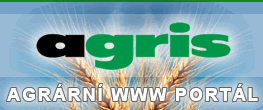THE INFLUENCE OF DIFFERENT RATES OF FERTILISATION AND IN ABSENCE OF N-FERTILISATION ON FORAGE-QUALITY OF PERMANENT GRASSLAND FROM THE POINT OF VIEW OF DEMANDS OF CATTLE
09.12.1999 | Odborné konference
VLIV RU ZNÉ ÚROVNĚ HNOJENÍ A VYPUŠTĚNÍ N-HNOJENÍ NA KVALITU PÍCE TRVALÉHO TRAVNÍHO POROSTU Z HLEDISKA POŽADAVKU SKOTU
M. Skála, J. Mrkvička
Czech University of Agriculture, Praha, Czech Republic
Summary
Quality of forage of intensively used permanent grassland from the point of view of demands of cattle was studied. Chemical analyses of the herbage based on samples taken from one intensively managed permanent grassland, characterised by different species composition, confirm some adverse effects of the intensification of the production of forage. Analysed dry matter of permanent grassland showed worse quality of fodder compared with demands of cattle from the point of view of optimal nutrition.
permanent grassland, quality of forage, N-fertilisation, elimination of N-fertilisation
Souhrn
V jednoletém pokusu, uskutečněném na experimentálním stanovišti Černíkovice, byla sledována jednak kvalita píce dlouhodobě hnojeného trvalého travního porostu (TTP) a jednak kvalita píce téhož TTP po vypuštění N-hnojení (v roce 1992). Výsledky ukázaly, že píce svým nutričním složením zcela neodpovídá požadavkům na optimální výživu skotu. Disonance mezi skutečně zjištěným obsahem živin v píci a obsahem, který je požadován z aspektu optimální výživy skotu byla shledána zejména u draslíku. Také u fosforu, vápníku a hořčíku byly zjištěny obsahy vyší než odpovídá požadavkům na optimální výživu skotu. U těchto prvků je však nebezpečný především deficit v píci. Výsledky, týkající se kvality píce TTP v jednotlivých sečích roku 1998, jsou sumarizovány v tab. 1 - 3.
trvalý travní porost, kvalita píce, N-hnojení, vypuštění N-hnojení
Introduction
High quality of forage can be obtained from meadows and pastures if, first of all, there is a balanced ratio of nutrient in the soil. At present, the main concern is to provide a rational nitrogen and potassium, well-balanced with phosphorus, if high quality herbage is to be produced (BEDRNA - 1985). A deficit of mineral substances including micro- and macroelements, or their inadequate ratio in the fodder, affects the health of the most productive animals (VESELÝ et al. - 1984). Other substances (vitamins, crude fibre) also play a very important role in animal nutrition (LABUDA et al. - 1982). Above all nitrogen is, among other factors, an evidently decisive regulator of herbage quality (VELICH - 1986).
MATERIAL AND METHODS
The trial with long-term pratological study was found already in the 1966 year. The experiment was established by the method of randomised blocs in four replications. All experimental plots are long-term (starting by 1975) fertilised with different rates of fertiliser (01 - P30K1002 - N100P30K1003 - N200P30K1004 - N300P30K1005 - N400P30K1006 - lower index means kg per ha, upper index means number of variant). Original experimental plots (5 x 6 m of size) were distributed in the 1992 year and N-fertilisation was eliminated in a half of plots (variants with 0). Rates of N (100 - 400 kg.ha-1) were divided for application to each cut. The form of N-fertiliser was ammonium nitrate with limestone (LAV 27,5). Phosphorus (40 kg.ha-1) was supplied in the form of superphosphate in autumn and potassium (100 kg.ha-1) in potassium salt applied after the first cut.
The experiment was carried out in the 1998 year at an experimental meadows, which is situated in the vicinity of Černíkovice village. The experimental area belongs to the potato producing type (rainfall factor according to Lang, i.e. the ratio of average total annual precipitation to annual mean air temperature is 79). The stand is at an altitude of 363 m above the sea level. The average precipitation sum from January to December is 617 mm (March to October 397 mm), average annual temperature 7,8 oC. The average groundwater table is 0,55 m under surface with seasonal variation of 0,1 to < 1 m. Cox content in the 0 - 0,2 m layer is 2,90 %, Nt content 0,41 %, pH (KCl) was 5,0, maximum sorption capacity 37,8 mval per 100 g, and saturation of the sorption complex with bases was 66,1 %.
In the area of production function of experiment was above all focused on detecting quality of forage from permanent meadow stand. After cutting, samples of above-ground biomass from individual variants of fertilisation were dried, weighed, crushed and finally analysed according to common methods.
Quality of forage was tested in collaboration with Research Institute for Soil and Water Conservation - Prague Zbraslav. Quality of forage was tested not only on long-term fertilised plots, but also on sites, where N-fertilisation was eliminated.
RESULTS AND DISCUSSION
Contents of individual components in dry matter in all cuts in the 1998 year are summarised in the table 1 - 3.
The total content of potassium in dry matter ranged from 2,05 to 3,65 %. The highest concentration of potassium was found in the first cut and then decreased towards the third cut. In spite of K-fertilisation after the first cut as is generally recommended (MRKVIČKA - 1990, VELICH et al. - 1994, KVÍTEK - 1995), content of potassium in dry matter in all variants exceeded 2 % (demand of cattle from the point of view of optimal nutrition), and is, therefore, possible to state that dose 100 kg of K per 1 ha is too high for this stand. Obtained results, concerning potassium, confirmed high ability of grasses to accept this element, but this so-called “luxury intake” is not desirable, because high content of potassium in dry matter decreases taste of fodder.
The total content of phosphorus in dry matter ranged from 0,29 to 0,52 %. In most variants the content of phosphorus in dry matter exceeded 0,30 % (demand of cattle from the point of view of optimal nutrition). On the base of evaluation of the table 1 - 3 it is possible to state, that content of this element is increasing from the first cut towards the third cut.
In most variants content of magnesium in dry matter exceeded 0,20 % (demand of cattle from the point of view of optimal nutrition). Different situation was as regards calcium. While in the first cut all variants fertilised with original rates of fertiliser and control variant showed higher content of calcium in herbage dry matter than is demanded from the point of view of optimal nutrition (0,70 %), in case of variants, where N-fertilisation was eliminated were recorded values lower than 0,70 %. In next cuts situation was similar as in the event of magnesium and all variants of fertilisation (except variants 2 and 03 in the third cut) showed content of this element in herbage dry matter higher than is demanded from the point of view of optimal nutrition. Gradated nitrogen application rates resulted in a slight drop of concentration of calcium and magnesium in herbage dry matter. It was probably caused by retreat of herbs and legumes, which has higher content of these elements than grasses. Similar results were recorded by MRKVIČKA (1990).
The highest concentration of nitrates was usually found in the event of the first cut. Toxic limit (500 mg NO3- per 1 kg of dry mass) was exceeded in case of variants 4, 05, 5 and 6 (the first cut) and variant 6 in the second and third cut. Dead limit (1500 mg NO3- per 1 kg of dry mass) was exceeded in case of variant 5 in the first cut and variant 6 in all cuts. On the base of obtained data regarding nitrates it is possible to state, that dose over 200 kg of N per 1 ha can on this stand results in exceeding of dangerous limit 500 mg NO3- per 1 kg of dry mass.
Unlike some published results (KLEČKA et al. - 1938, BUKVAJ - 1974) gradated nitrogen application rates increased the concentration of crude fibre in herbage dry matter. Same results regarding the influence of nitrogen fertilisation on concentration of crude fibre in herbage dry matter were described by FIALA (1990). In conformity with all published data gradated nitrogen application rates increase the concentration of crude protein too.
REFERENCES
Bukvaj, M., 1974: Vliv rychloobnovy a intenzivní výživy na kvalitu a výnosovou úroveň nekulturních travních porostů. VŠZ Praha.
BEDRNA, Z., 1985: Harmonický poměr živin v půdě a produkce rostlin. Zvyšovat kvalitu rostlinných výrobků. Praha.
FIALA, J., 1990: Effects of long-continued nitrogen fertilization on nutrient concentration in the soil and herbage of permanent grassland. Rostlinná výroba, 36, pp. 519-528.
Klečka, A. a kol., 1938: Pícninářství v teorii a praxi. Čs. pícninářský spolek, Praha.
KVÍTEK, T. a kol., 1995: Zásady delimitace kultur a využívání travních porostů v útlumových - extenzivních podmínkách. VÚMOP - Praha.
LABUDA, J. a kol., 1982: Výživa a krmenie hospodárskych zvierat. Bratislava, Príroda.
Mrkvička, J., 1990: Produkční a ochranné funkce trvalých lučních porostů. Habilitační práce, VŠZ Praha.
Velich, J. a kol., 1994: Pícninářství. VŠZ Praha.
VELICH, J., 1986: Studium vývoje produkční schopnosti trvalých lučních porostů a drnového procesu při dlouhodobém hnojení a jeho optimalizace. VŠZ Praha.
VESELÝ a kol., 1984: Výživa a krmení hospodářských zvířat. SZN Praha.
Ing. Marcel Skála, Doc, Ing. Jiří Mrkvička, CSc.
ČZU Praha, katedra pícninářství
Kamýcká ul.
Praha 6 - Suchdol
165 21
Další články v kategorii Zemědělství
- Babiš vloží Agrofert do fondu RSVP Trust (23.12.2025)
- Tento legendární stroj měnil venkov: Příběh nejrozšířenějšího traktoru Evropy (23.12.2025)
- Letos se objevilo ve velkochovech deset ohnisek ptačí chřipky, stejně jako loni (22.12.2025)
- Uhlíkově negativní zemědělství: Jak ho můžeme dosáhnout v českých podmínkách? (22.12.2025)
- Ve velkochovu slepic na Havlíčkobrodsku veterináři potvrdili ptačí chřipku (21.12.2025)
- Ve Stálkách na Znojemsku postaví zemědělci šest nových hal pro chov brojlerů (19.12.2025)
- Dohoda EU s Mercosurem o obchodu se odkládá na leden, uvedla von der Leyenová (19.12.2025)
- Německo a Španělsko vyzvaly lídry EU k podpoře dohody s Mercosurem (19.12.2025)
- Opakované demonstrace zemědělcům dobré jméno neudělají (19.12.2025)
- V Bruselu protestují tisíce zemědělců proti zemědělské politice EU (19.12.2025)

 Tweet
Tweet





